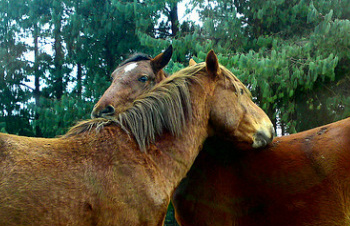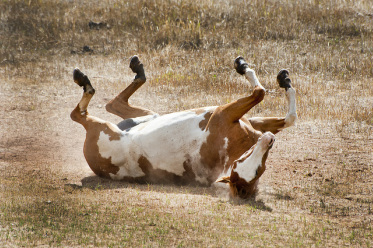Why do we groom horses?
In the wild, horses take care of their own skin. They do this by rolling (which helps remove dead skins cells and exfoliates the skin), rubbing against branches, and by means of mutual grooming. Mutual grooming is when two horses rub and nip each other with their front incisor teeth. This results in a relaxing massage for both horses and is often done in hard-to-reach places, therefore aiding the horse in its grooming. Domestic horses, however, are often stalled, blanketed, separated from others, and ridden. These differences in environment lead us to need to groom them.
Grooming is an important aspect of horse care because, not only does it improve the horse's appearance, it also promotes good health (by removing dirt and sweat as well as preventing saddle sores and girth galls), improves circulation as well as muscle tone, and enables the handler to "get to know" the horse. Grooming your horse regularly also allows you to check them for injury (eg. cuts from the fence), skin disorders (eg. rain rot) and hoof problems (eg. cracked heel). It is not necessary to groom your horse every day, but you should do so before saddling or blanketing them. If a horse is constantly blanketed, it is important to take the blanket off and brush them every day because they are unable to self or mutual-groom and therefore the dead skin cells and hair builds up. While picking your horse's hooves out daily is not mandatory, it should take priority over body brushing. This is because stones can get stuck in a horses hoof, causing them great discomfort, and wet or muddy turn-out conditions increase the risk of hoof problems such as thrush (which is killed when exposed to oxygen).
Grooming is an important aspect of horse care because, not only does it improve the horse's appearance, it also promotes good health (by removing dirt and sweat as well as preventing saddle sores and girth galls), improves circulation as well as muscle tone, and enables the handler to "get to know" the horse. Grooming your horse regularly also allows you to check them for injury (eg. cuts from the fence), skin disorders (eg. rain rot) and hoof problems (eg. cracked heel). It is not necessary to groom your horse every day, but you should do so before saddling or blanketing them. If a horse is constantly blanketed, it is important to take the blanket off and brush them every day because they are unable to self or mutual-groom and therefore the dead skin cells and hair builds up. While picking your horse's hooves out daily is not mandatory, it should take priority over body brushing. This is because stones can get stuck in a horses hoof, causing them great discomfort, and wet or muddy turn-out conditions increase the risk of hoof problems such as thrush (which is killed when exposed to oxygen).
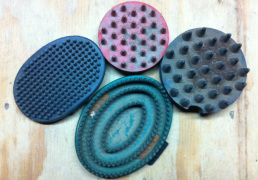
Rubber curry comb:
Generally used first, applying pressure in a circular motion, to remove dirt and loose hair. Many horses really enjoy being curried because the rhythmic motion and pressure acts like a relaxing massage.
Generally used first, applying pressure in a circular motion, to remove dirt and loose hair. Many horses really enjoy being curried because the rhythmic motion and pressure acts like a relaxing massage.
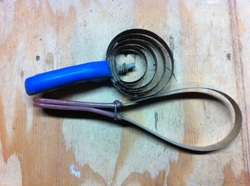
Metal scraper or curry comb:
This flexible metal blade with "teeth" is used to remove dirt from heavy coats, assist in the loosening and removal of hair during shedding season, and to clean body brushes.
This flexible metal blade with "teeth" is used to remove dirt from heavy coats, assist in the loosening and removal of hair during shedding season, and to clean body brushes.
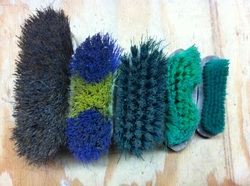
Dandy or hard brush:
A stiff-bristled brush helps remove larger dirt particles brought up by the curry comb and should be used with short wrist strokes, ending in an upward sweep, and done in the direction that the hair lies.
A stiff-bristled brush helps remove larger dirt particles brought up by the curry comb and should be used with short wrist strokes, ending in an upward sweep, and done in the direction that the hair lies.
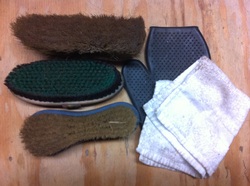
Body or soft brush:
A soft, short-bristled brush can be used after the hard brush to remove any finer dirt.
Face mitt or towel:
It is important to only use soft brushes on the face. Some horses also really enjoy being rubbed with a face mitt, which acts like a gentler curry comb. A wet towel can be used to clean the horse's eyes and nose.
A soft, short-bristled brush can be used after the hard brush to remove any finer dirt.
Face mitt or towel:
It is important to only use soft brushes on the face. Some horses also really enjoy being rubbed with a face mitt, which acts like a gentler curry comb. A wet towel can be used to clean the horse's eyes and nose.
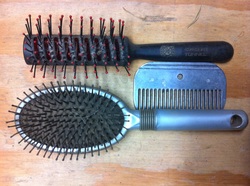
Plastic and metal combs:
Plastic combs or brushes are used to comb the mane and tail. Make sure to use a detangler spray for any tangles, or else you risk further knotting or breaking the hair. A metal comb, however, should be reserved for pulling the mane or plaiting the tail.
Plastic combs or brushes are used to comb the mane and tail. Make sure to use a detangler spray for any tangles, or else you risk further knotting or breaking the hair. A metal comb, however, should be reserved for pulling the mane or plaiting the tail.
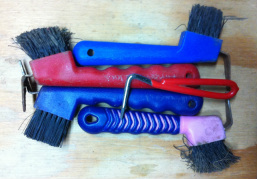
Hoof pick:
This tool is used on all parts of the hoof and is arguably the most important part of your grooming kit. It can be used to clean out mud and manure from around the frog as well as off the outside of the hoof. A pick is also necessary to remove any stones or other foreign objects which could bruise the horse's sensitive hoof and cause them to go lame. Keeping your horses' hooves clean is important to prevent both disease and injury.
This tool is used on all parts of the hoof and is arguably the most important part of your grooming kit. It can be used to clean out mud and manure from around the frog as well as off the outside of the hoof. A pick is also necessary to remove any stones or other foreign objects which could bruise the horse's sensitive hoof and cause them to go lame. Keeping your horses' hooves clean is important to prevent both disease and injury.
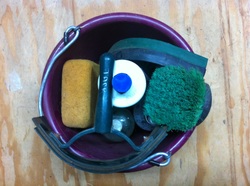
Sweat scraper:
A long or curved metal, plastic or wooden tool used to remove excess water from a horse's coat after being hosed off or sponged. It is used in a similar way to a squeegee on a car window.
A long or curved metal, plastic or wooden tool used to remove excess water from a horse's coat after being hosed off or sponged. It is used in a similar way to a squeegee on a car window.
